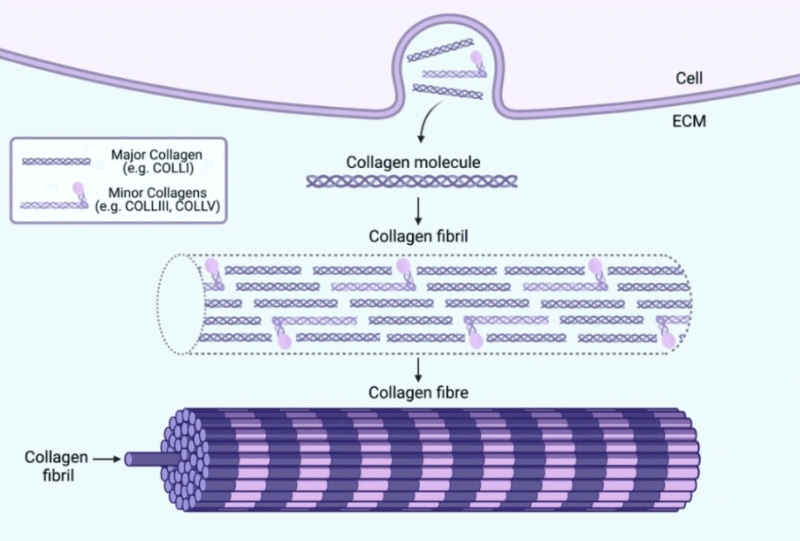
What Happens When Collagen Breaks Down? Understanding Ehlers–Danlos Syndrome
Kabilan K. L., Pediatric Cardiac Nurse at Towards Building Health, shared on LinkedIn.
”𝙒𝙝𝙖𝙩 𝙞𝙨 𝙀𝙝𝙡𝙚𝙧𝙨-𝘿𝙖𝙣𝙡𝙤𝙨 𝙎𝙮𝙣𝙙𝙧𝙤𝙢𝙚 ?
EDS is a group of inherited (genetic) disorders that affect the body’s connective tissues — in particular collagen and other supporting structures.
Connective tissue is like the body’s “glue” and “scaffolding” — it supports skin, joints, blood vessels, organs, and more.
Because the connective tissue is weaker or abnormal, people with EDS have characteristic features such as loose or overly flexible joints, stretchy skin, fragile tissue, and in some forms, serious vascular or organ-risks.
How it Works (Pathophysiology and Genetics)
Many forms of EDS are caused by mutations in genes that code for collagen or enzymes, processes that build, shape or cross-link collagen.
When collagen is defective, the connective tissue ends up being weaker, more stretchy, less supportive. For example, blood vessel walls may be thinner or less resilient; skin may stretch more and bruise easily; ligaments may allow joints to move beyond normal limits.
There are 13 major subtypes of EDS recognized (as of recent classification) — each with somewhat different gene defects and clinical features.
Common Signs and Symptoms.
Typical features to look for:
Joint hypermobility: Joints that move beyond the usual range, frequent sprains, dislocations, sub-luxations.
Skin differences: Skin may be very stretchy (hyperextensible), unusually soft or velvety, bruise easily, heal poorly or with abnormal scars.
Vascular, organ risk (in certain subtypes): Fragile blood vessels, risk of arterial rupture or organ rupture (especially in the vascular subtype).
Other symptoms may include chronic pain (especially joint and muscle pain), fatigue, early-onset osteoarthritis, scoliosis or spinal issues, gastrointestinal problems, among others.
Because connective tissue is everywhere, the effects can show up in many organ systems — not just skin and joints.
Types and Classification
There are multiple forms of EDS — here are three fairly common ones:
Classical EDS: Features often include skin hyperextensibility, abnormal scarring, joint hypermobility.
Hypermobile EDS (hEDS): The most common subtype; primarily joint hypermobility, less obvious skin involvement; gene cause not fully established.
Vascular EDS (vEDS): One of the more serious forms, with risk of life-threatening blood vessel or organ rupture.
Diagnosis and Monitoring
Diagnosis usually involves clinical evaluation (looking for joint hypermobility, skin signs, family history) and possibly genetic testing depending on subtype.
For joint hypermobility evaluation, tools like the Beighton score may be used.
In some subtypes, monitoring of cardiovascular system (e.g., aorta, arteries) is important because of rupture risk.
Because EDS is variable, diagnosis may be delayed or missed. Awareness is key.
Treatment and Management
There is no cure for EDS (as of now) — management is supportive.
Stay Consistent.”

Stay updated with Hemostasis Today.
-
Nov 3, 2025, 08:23The 1st Participant in A New CHECK-NIRS Clinical Study is Enrolled!
-
Nov 3, 2025, 08:15Bert van Meurs Shares the New Late-breaking Results from the iMODERN Trial
-
Nov 3, 2025, 07:10Lisa Shea Shares Key Takeaways from NORD Summit 2025
-
Nov 3, 2025, 06:49Darshan Doshi on Results of iMODERN and ILIAS ANOCA Studies Presented at TCT 2025
-
Nov 2, 2025, 14:172019 ESC/EAS Guidelines for the Management of Dyslipidaemias Discussion with Lale Tokgözoğlu and Jeanine Roeters van Lennep
-
Nov 3, 2025, 09:13Claudio Carrubba on How Timing Truly Matters in Trauma Embolization
-
Nov 3, 2025, 08:46Rachel Lamerton and Colleagues on Activation of Platelets in Flow Cytometry
-
Nov 3, 2025, 04:56Nirupama Ramadas and Erica Sparkenbaugh on Thromboinflammation in SCD
-
Nov 2, 2025, 14:21Claude Franceschi: I Advise You to Understand the Hemodynamic Pathophysiology of Venous Diseases Rather than Blindly Applying Ablation Techniques or Venous Stent Placement
-
Nov 2, 2025, 14:15Krishna Aragam: Why are (DCM) and Heart Failure About Twice as Common in Individuals of Self-Identified Black Race?
-
Oct 29, 2025, 07:31The Use of Artificial Intelligence to Improve Detection of Acute Incidental Pulmonary Emboli - JTH
-
Oct 29, 2025, 07:05Shrinidhi Nathany: AI in Diagnostic Medicine
-
Oct 28, 2025, 07:02Aya Berman: AI Model for Predicting Bacteremia
-
Oct 28, 2025, 06:55The New Era of Genomics, AI and Cell Therapy in Hematology and Infectious Diseases
-
Oct 28, 2025, 06:49Lukas Gaats: Researchers Are Building Reproductive Organoids
-
Nov 3, 2025, 09:24Stephen Cornelissen: It’s Not Just About Emergencies — It’s About Everyday Care, Chronic Conditions and Hope
-
Nov 3, 2025, 06:57Maria Elisa Mancuso Reflects on 2025 Annual Congress of the Italian Association of Hemophilia Centres
-
Nov 3, 2025, 05:46Chandra Viswanathan: When Blood Safety Fails, We All Bleed - A Call for Reform and Responsibility
-
Nov 2, 2025, 14:17Anamaria B: Your Mother Still Runs Part of Your DNA
-
Nov 2, 2025, 10:57Paul Bolaji on Launching The First Centralised Nigerian National Stroke Registry
